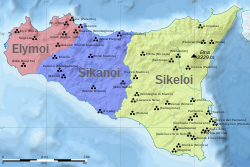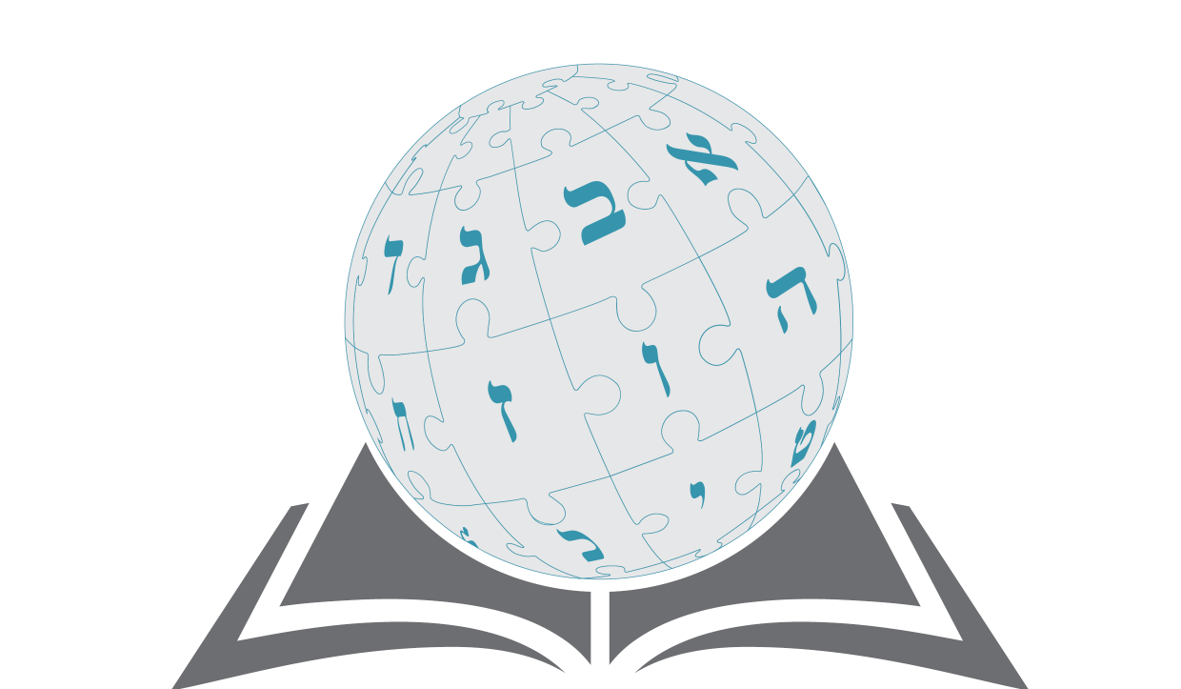סיקלי

הסיקלי (בלטינית: Sicelī או Siculī) היו שבט הודו-אירופי שאכלס את מזרח אמצע סיציליה, בתקופת הברזל. הם דיברו בשפה הסיקולית. לאחר תבוסת הסיקלים בקרב נומה (אנ') בשנת 450 לפנה"ס ומותו של מנהיג הסיקלי דוקטיוס (אנ') בשנת 440 לפנה"ס, התפרקה המדינה הסיקלית ותרבות הסיקלי התמזגה לתוך מגנה גראסיה (יוון הגדולה).
היסטוריה

חפירה ארכאולוגית הראתה השפעה מיקנית מסוימת על סיציליה מתקופת הברונזה. האזכור הספרותי המוקדם ביותר של הסיקלי הוא באודיסאה. הומרוס מזכיר גם את הסיקאני, אבל לא עושה הבחנה ביניהם: "הם היו (מ)מקום רחוק ועם רחוק וככל הנראה הם היו אותו דבר". עבור הומרוס, מציין רובין ליין פוקס.[1]
ייתכן שהסיקלי והסיקאני של תקופת הברזל היו מורכבים מאוכלוסייה אילירית אשר (כמו אצל המסאפים - שבט יאפיגי) כפתה את עצמה על אוכלוסייה מקומית, פרה-הודו-אירופית ("ים תיכונית").[2] תוקידידס[3] וסופרים קלאסיים אחרים היו מודעים למסורות שלפיהן חיו בני שבט הסיקלי בעבר במרכז איטליה, ממזרח ואף מצפון לרומא.[4] משם הם נעקרו ונדחקו דרומה על ידי שבטים אומבריים וסאביים, ולבסוף עברו לסיציליה. נראה שהארגון החברתי שלהם היה שבטי, כלכלית וחקלאית. לפי דיודורוס סיקולוס,[5] לאחר סדרה של סכסוכים עם הסיקאני, נהר סלסו הוכרז כגבול בין הטריטוריות שלהם.
שפה
מחקרים לשוניים העלו שייתכן שהסיקלי דיברו בשפה הודו-אירופית[6] וכבשו את מזרח סיציליה כמו גם את איטליה הדרומית ביותר[7] בעוד שהאלימי (מיוונית Elymoi) והסיקאני (ביוונית: Sikanoi) ישבו במרכז ובמערב סיציליה. סביר להניח שהסיקאני דיברו בשפה שאינה הודו-אירופית, הסיווג של שפתם נותר לא ברור. לעומת זאת, השפה האלימית מקובלת ככלל שהייתה שפה הודו-אירופית, אם כי הסיווג המדויק שלה בתוך המשפחה אינו ברור.[8] יש הרואים שהיא קשורה לליגורית,[9] בעוד שאחרים משדכים אותה לשפות האיטליות.[10]
ראו גם
ביבליוגרפיה
- Antonaccio, Carla M., and C. M. Antonacchio. "Κυπάρα, a Sikel Nymph?" Zeitschrift Für Papyrologie Und Epigraphik 126 (1999): 177-85. JSTOR 20190439.
- Bernabò Brea, Luigi. 1966. Sicily before the Greeks. Revised edition. New York: F.A. Praeger.
- Boardman, John, editor. 1988. The Cambridge Ancient History. Volume 4, Persia, Greece and the Western Mediterranean, C.525 to 479 BC. 2nd edition. Cambridge: Cambridge University Press.
- Citter, Carlo, Giuseppe Maria Amato, Valentina Di Natale, and Andrea Patacchini. 2017. "A Stratified Route Network in a Stratified Landscape: The Region of Enna (Central Sicily) from the Bronze Age to the 19th c. AD." Open Archaeology 3 (1): 305–12.
- Ferrer, Meritxell. 2016. "Feeding the Community: Women's Participation in Communal Celebrations, Western Sicily (Eighth–Sixth Centuries BC)." Journal of Archaeological Method and Theory 23 (3): 900–20.
- Knapp, A. Bernard, and Peter van Dommelen, editors. 2014. The Cambridge Prehistory of the Bronze and Iron Age Mediterranean. Cambridge: Cambridge University Press.
- Leighton, Robert. 1999. Sicily before History: An Archaeological Survey From the Palaeolithic to the Iron Age. Ithaca, NY: Cornell University Press.
- ————. 2015. "Rock-cut Tombs and Funerary Landscapes of the Late Bronze and Iron Ages in Sicily: New Fieldwork at Pantalica." Journal of Field Archaeology 40 (2): 190–203.
- Martzloff, Vincent. Variation linguistique et exégèse paléo-italique. L’idiome sicule de Montagna di Marzo. In: La variation linguistique dans les langues de l’Italie préromaine. Lyon : Maison de l'Orient et de la Méditerranée Jean Pouilloux, 2009. pp. 93-132. (Collection de la Maison de l'Orient méditerranéen ancien. Série philologique) [www.persee.fr/doc/mom_0184-1785_2009_act_45_1_1985]
- Mentesana, Roberta, Giuseppe De Benedetto, and Girolamo Fiorentino. 2018. "One Pot's Tale: Reconstructing the Movement of People, Materials and Knowledge in Early Bronze Age Sicily through the Microhistory of a Vessel." Journal of Archaeological Science: Reports 19: 261–69.
- Oren, Eliezer D. 2000. The Sea Peoples and Their World: A Reassessment. Philadelphia: The University Museum, University of Pennsylvania.
- Russell, Anthony. 2017. "Sicily without Mycenae: A Cross-Cultural Consumption Analysis of Connectivity in the Bronze Age Central Mediterranean." Journal of Mediterranean Archaeology 30 (1): 59–83.
קישורים חיצוניים
הערות שוליים
- ↑ Fox, Travelling Heroes in the Epic Age of Homer, 2008:115; Homer's references are in Odyssey 20,383; 24.207-13, 366, 387-90.
- ↑ Fine, John (1985). The ancient Greeks: a critical history. Harvard University Press. p. 72. ISBN 0674033140.
Most scholars now believe that the Sicans and Sicels, as well as the inhabitants of southern Italy, were basically of Illyrian stock superimposed on an aboriginal "Mediterranean" population".
- ↑ The concern of Thucydides is to acquaint his Athenian audience with the cultural and historical background to Athenian invention in Sicilians affairs, beginning in 415 BC, in his book vi, sections 2.4-6.
- ↑ Servius' commentary on Aeneid VII.795; Dionysius of Halicarnassus i.9.22.
- ↑ Diodorus Siculus V.6.3-4.
- ↑ The basic study is Joshua Whatmough in R.S. Conway, J. Whatmough and S.E. Johnson, The Prae-Italic Dialects of Italy (London 1933) vol. 2:431-500; a more recent study is A. Zamponi, "Il Siculo" in A.L. Prosdocimi, ed., Popoli e civiltà dell'Italia antica, vol. 6 "Lingue e dialetti" (1978949-1012.)
- ↑ Thucydides reported that there were still Siculi in Italia, which only referred approximately to the modern Calabria in his time; he derived Italia from an eponymous Italos, a Sicel king (Histories, vi.4.6), cf. Name of Italy.
- ↑ Marchesini, Simona (2012). "The Elymian Language". In Tribulato, Olga (ed.). Language and Linguistic Contact in Ancient Sicily. Cambridge: Cambridge University Press. pp. 95–114. doi:10.1017/CBO9781139248938.005. ISBN 9781139248938.
All scholars agree that Elymian is a language of the Indo-European family (p. 96).
- ↑ Braccesi, Lorenzo (1993). Hesperìa: studi sulla grecità di occidente (באיטלקית). L'ERMA di BRETSCHNEIDER. ISBN 978-88-7062-809-8.
- ↑ "Elimo".
סיקלי39217690Q959419


